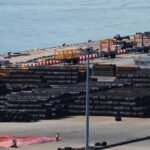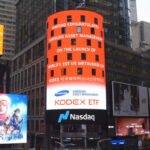SK Hynix Inc., the world’s No. 2 memory chipmaker, has made a significant business turnaround in the US and China, which made up 80% of its sales, as the buoyant AI chip demand drove the prices of high-performing chips such as high-bandwidth memory (HBM) and NAND flash higher.
The top AI chip supplier of Nvidia Corp., which controls 80% of AI chips, saw its US sales nearly triple to 15.98 trillion won ($11.8 billion) in the first half of this year, compared with 5.47 trillion won in the year prior, according to its half-year financial reports published last week.
The US accounted for 55.4% of SK Hynix’s 28.85 trillion won sales recorded in the first six months of this year, more than double the previous year’s 12.39 trillion won.
In China, it raked in 8.61 trillion won in sales in the first half of this year, more than twice the prior year’s 3.88 trillion won. The neighboring country made up 29.8% of SK Hynix’ sales.
On top of the average selling price increase for both traditional and high-performing memory chips, the growing demand for HBM3E, the fifth-generation HBM and solid-state drive for enterprise applications contributed to the shipment growth.
In the first half of this year, SK Hynix’s DRAM sales expanded by more than 10 trillion won on-year to 18.19 trillion won, led by next-generation memory double data rate 5 (DDR 5) and HBM.
Sales of NAND flash were up by 5.6 trillion won to 9.59 trillion won during the same period.
In the second quarter of this year, SK Hynix posted its largest-ever quarterly revenue and its highest operating profit in six years.
LPDDR DRAM chips boast low power consumption and high performance
US, CHINA UNITS
Its US sales arm SK Hynix America swung to a net profit of 165.2 billion won in the first half ended in June from a 74.1 billion won loss in the year prior. Its revenue nearly tripled to 12.19 trillion won, versus 4.27 trillion won over the same period.
In China, SK Hynix operates a chip foundry unit in Wuxi; a chip packaging factory in Chongqing; and a NAND flash plant in Dalian that it acquired in 2021.
In the first half of this year, the Wuxi’ factory operation turned to a net profit of 119.4 brillion won from a loss of 165.6 billion won in the year prior.
Given that the Wuxy plant’s half-year sales remained steady at around 2.7 trillion won, its turnround indicated the rise in DRAM’s operating margin.
By Jeong-Soo Hwang
hjs@hankyung.com
Yeonhee Kim edited this article













